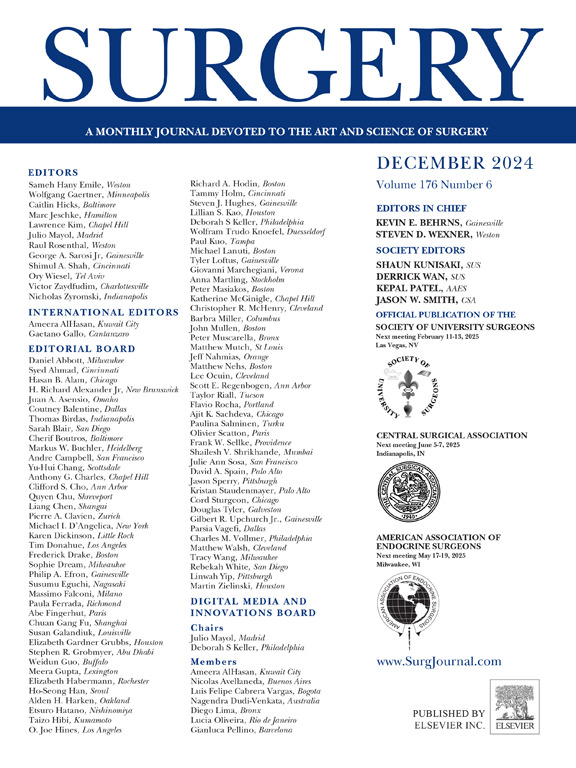终末期肾病患者经导管与外科二尖瓣介入治疗的比较
IF 3.2
2区 医学
Q1 SURGERY
引用次数: 0
摘要
终末期肾病患者发生二尖瓣钙化和功能障碍的风险增加。本研究通过一项全国队列研究,评估了终末期肾病患者经导管与外科二尖瓣置换术/修复术的临床和财务结果。方法回顾性分析全国再入院数据库(2016-2021)中所有接受孤立手术二尖瓣置换术/修复或经导管二尖瓣置换术/修复的终末期肾病成年患者。结果包括住院死亡率、30天非选择性再入院、并发症、住院费用、住院时间和非家庭出院。熵平衡和多变量回归对组间差异进行了校正,结果以校正比值比和95%置信区间报告。结果3782例终末期肾病患者中,12.8%接受了经导管二尖瓣置换术/修复,使用率从2016年的49例显著增加到2021年的122例(NPTrend <;0.001)。接受经导管二尖瓣置换术/修复术的患者年龄较大(70岁vs 58岁,P <;.001),且房颤发生率更高(57.8% vs 46.8%, P <;.001)和二尖瓣狭窄(21.7% vs 8.6%, P <;措施)。经过熵平衡和风险调整(以外科二尖瓣置换术/修复术为参照),经导管二尖瓣置换术/修复术并没有改变住院死亡率(校正优势比1.70;置信区间,0.96-2.99),30天再入院(调整优势比,0.99;置信区间,0.62-1.59)或住院费用(β - 4.4万美元,置信区间,- 20.3万美元至11.6万美元)。经导管二尖瓣置换术/修复术与输血几率降低相关(校正优势比,0.45;可信区间为0.29-0.72)、传染性(校正优势比;0.53,可信区间0.32-0.88)和呼吸(校正优势比0.34;可信区间,0.24-0.47)并发症和非居家出院(调整优势比;0.29,置信区间0.17-0.50)。总之,我们的研究强调了二尖瓣干预的发展前景,强调了手术二尖瓣置换术/修复和经导管二尖瓣置换术/修复的互补作用。越来越多的采用经导管二尖瓣置换术/修复反映了其良好的安全性和改善的出院结果,特别是在老年人和高危患者中。未来的研究应侧重于进一步评估长期结果,并探索提高这两种干预措施的成本效益和可及性的策略。本文章由计算机程序翻译,如有差异,请以英文原文为准。

Transcatheter compared with surgical mitral valve intervention in patients with end-stage renal disease
Introduction
Patients with end-stage renal disease are at increased risk for developing mitral valve calcification and dysfunction. The present study evaluated clinical and financial outcomes of transcatheter compared with surgical mitral valve replacement/repair in patients with end-stage renal disease using a national cohort.
Methods
This was a retrospective analysis of all adult patients with end-stage renal disease receiving isolated surgical mitral valve replacement/repair or transcatheter mitral valve replacement/repair in the Nationwide Readmissions Database (2016–2021). Outcomes included in-hospital mortality, 30-day nonelective readmissions, complications, hospitalization costs, length of stay, and nonhome discharge. Entropy balancing and multivariable regressions adjusted for intergroup differences, with results reported as adjusted odds ratios and 95% confidence intervals.
Results
Among 3,782 patients with end-stage renal disease, 12.8% underwent transcatheter mitral valve replacement/repair, with use significantly increasing from 49 cases in 2016 to 122 cases in 2021 (NPTrend < 0.001). Patients undergoing transcatheter mitral valve replacement/repair were older (70 vs 58 years, P < .001) and had greater rates of atrial fibrillation (57.8 vs 46.8%, P < .001) and mitral stenosis (21.7 vs 8.6%, P < .001). After entropy balancing and risk adjustment (with surgical mitral valve replacement/repair as reference), transcatheter mitral valve replacement/repair did not alter the odds of in-hospital mortality (adjusted odds ratio, 1.70; confidence interval, 0.96–2.99), 30-day readmissions (adjusted odds ratio, 0.99; confidence interval, 0.62–1.59), or hospitalization costs (β −$4.4K, confidence interval, −$20.3K to $11.6K). Transcatheter mitral valve replacement/repair was associated with reduced odds of blood transfusion (adjusted odds ratio, 0.45; confidence interval, 0.29–0.72), infectious (adjusted odds ratio; 0.53, confidence interval, 0.32–0.88) and respiratory (adjusted odds ratio, 0.34; confidence interval, 0.24–0.47) complications, and non-home discharge (adjusted odds ratio; 0.29, confidence interval, 0.17–0.50).
Conclusion
In conclusion, our study underscores the evolving landscape of mitral valve interventions, highlighting the complementary roles of surgical mitral valve replacement/repair and transcatheter mitral valve replacement/repair. The increasing adoption of transcatheter mitral valve replacement/repair reflects its favorable safety profile and improved discharge outcomes, particularly in elderly and high-risk patients. Future research should focus on further evaluating long-term outcomes and exploring strategies to enhance the cost-effectiveness and accessibility of both interventions.
求助全文
通过发布文献求助,成功后即可免费获取论文全文。
去求助
来源期刊

Surgery
医学-外科
CiteScore
5.40
自引率
5.30%
发文量
687
审稿时长
64 days
期刊介绍:
For 66 years, Surgery has published practical, authoritative information about procedures, clinical advances, and major trends shaping general surgery. Each issue features original scientific contributions and clinical reports. Peer-reviewed articles cover topics in oncology, trauma, gastrointestinal, vascular, and transplantation surgery. The journal also publishes papers from the meetings of its sponsoring societies, the Society of University Surgeons, the Central Surgical Association, and the American Association of Endocrine Surgeons.
 求助内容:
求助内容: 应助结果提醒方式:
应助结果提醒方式:


